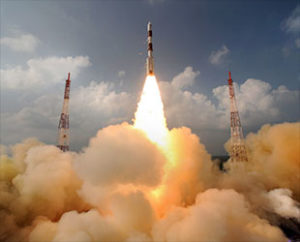
The Indian Space Research Organisation (ISRO) is developing a small launch vehicle that weighs no more than 100 tons that can loft a 500 kg satellite into a 500 km orbit. ISRO is currently earning about U.S.$40 million annually through launching small satellites for foreign customers, and aims to increase its revenue by using the small launch vehicle to serve the burgeoning small satellite market.
ISRO’s Small Satellite Launch Vehicle (SSLV) concept will not require a mission control centre to launch satellites as a personal computer would be more than enough for launch control, the space agency said in a statement on 29 August 2018.
“SSLV does not require mission control centre to launch the satellite. It can be launched from some personal computer anywhere,” Dr. K. Sivan, chairman of ISRO, said.
Space and satellite consultancy Euroconsult estimates that over 6,200 small satellites are expected to be launched by different countries over the next decade with a potential market value of around U.S.$30 billion, and ISRO’s SSLV intends to tap into this potential market.
“Definitely, India should be able to attract more global customers in this segment. Besides, it will also allow ISRO to concentrate on their back job that is Research and Development as the private sector is being involved in the project,” Ajey Lele, a senior fellow at the New Delhi-based Institute of Defense Studies and Analyses (IDSA), told Russian news outlet Sputnik.
The challenge, however, is that the small satellite launch market is becoming increasingly crowded in the Asia-Pacific region, with rival launch companies emerging in China with companies such as LandSpace and SpaceOne; Japanese launch companies such as Interstellar; and Gilmour Space Technologies of Australia and Singapore.
Furthermore, the increasingly crowded Asia-Pacific market says nothing about the numerous small satellite launch companies in North America and Europe that will also be competing to launch Asia-Pacific payloads in the coming years.
ISRO expects to begin operating the SSLV capability from mid-2019. The SSLV is estimated to cost one-tenth of a normal ISRO Polar Satellite Launch Vehicle (PSLV), which costs anywhere between U.S.$25 million to U.S.$75 million. The 100-ton SSLV will be designed to be assembled in only three days instead of the usual 60 days, and by six people instead of 600.
“SSLV’s launches will commence sometime in mid-2019. We want to involve the private sector from the beginning and will be offering them development and launches,” said Dr. K. Sivan, ISRO chairman, at a press conference to announce the 6th edition of the 2018 Bangalore Space Expo.
Since the SSLV is designed to be assembled in three days, ISRO hopes to achieve 50-60 launches a year. The SSLV is currently in its development stage and will then be farmed out to industry for mass production.
“Antrix is looking at 50/60 launches SSLVs a year and in the next 10 years, we see a business potential of around $300 million annually,” said Rakesh Sasibhushan, Chief Managing Director of the Antrix Corporation, the commercial arm of ISRO.
Currently ISRO is using the spare capacity available on PSLV launch missions for launching small satellites for other countries on a commercial basis through the Antrix Corporation. As of August 2018 ISRO has successfully launched 237 foreign satellites, mostly small satellites, from 29 countries, using the PSLV.





